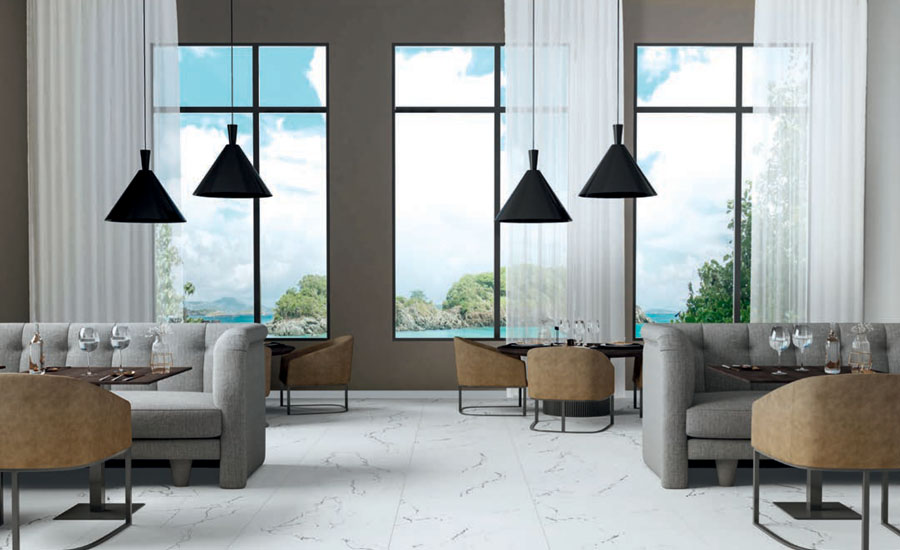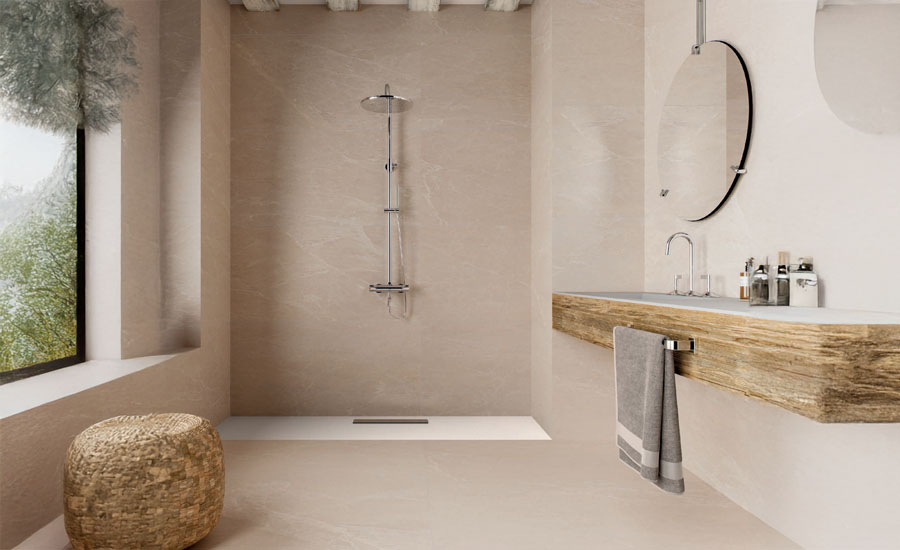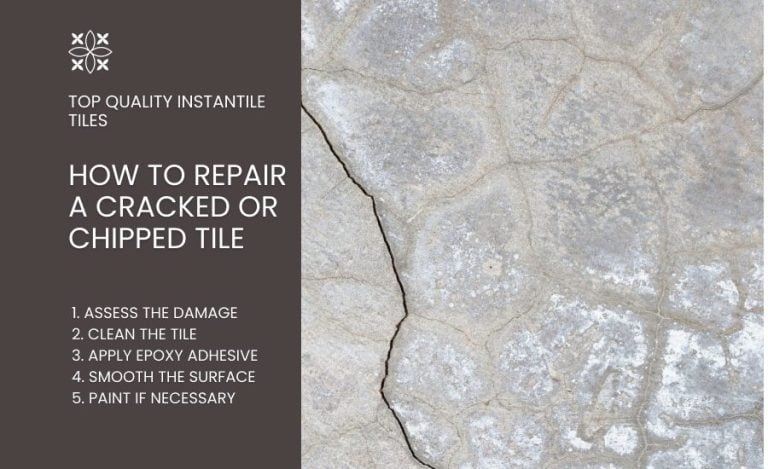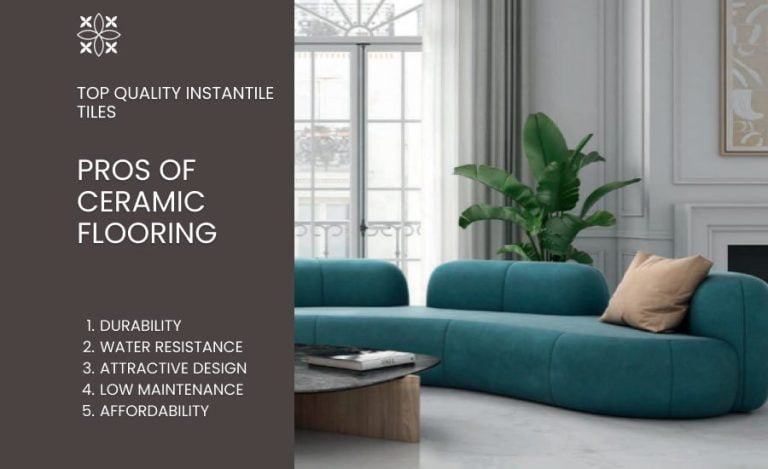Ceramic Tiles vs. Laminate Flooring: Key Takeaways
- Ceramic tile flooring is a durable, versatile choice made from natural clay, sand, and water
- Laminate flooring is a synthetic option with a fiberboard core, a photographic layer that mimics wood or stone, and a protective topcoat for durability
- Ceramic tiles, with their water resistance, are a better fit for kitchens, bathrooms, and laundry rooms
Installing the right flooring in a home or commercial space is a big investment, so it’s important to choose wisely.
You might be weighing the long-term durability of ceramic tiles against the budget-friendly appeal of laminate.
Both have their perks and pitfalls, and this guide helps you figure out which one fits your lifestyle best.
In this guide, we will:
- Share how ceramic tiles and laminate stack up so you can choose what really works for your space
- Provide clear answers to your biggest questions about ceramic vs. laminate flooring
- Present Ceramista’s collection of premium tiles designed for any residential or commercial space
Ceramic Tiles vs. Laminate Flooring
When choosing between ceramic tiles and laminate flooring, it’s important to consider several important factors.
Aesthetics
Ceramic tiles come in different designs, textures, and colors, often mimicking natural materials like wood, stone, or marble, which can enhance the appearance of any room.
Laminate flooring also mimics wood and stone, but with a more limited variety of designs and finishes compared to ceramic tiles, lacking the depth and texture of real materials.
Durability
Ceramic tiles are very sturdy and resistant to scratches, dents, and moisture, making them ideal for wet spaces like kitchens and bathrooms and high-traffic areas like lobbies, retail floors, conference rooms, and cafeterias.
Laminate flooring is durable to scratches (although less resistant than tiles) but vulnerable to moisture, making it unsuitable for wet environments.
Maintenance and Cleaning
Ceramic tiles need regular sweeping and mopping with a mild detergent, and that’s all to keep them clean and fresh! All you need to do is occasionally scrub their grout lines.
Laminate flooring maintenance is also easy, but you need to keep an eye for excessive water exposure, and it’s important to clean spills quickly to prevent warping.
Cost
Ceramic tiles are more expensive both as material and installation, especially if you want premium designs, but their durability makes them cost-effective long-term.
Laminate flooring is a more budget-friendly option; however, it may need to be replaced sooner due to wear and tear.
Sustainability
Ceramic tiles are more sustainable, as they are made from natural materials and sometimes at solar-powered facilities.
Laminate flooring is made from synthetic materials and may release volatile organic compounds (VOCs), which can have a higher environmental impact during production and disposal.

Ceramic Tile Flooring Explained
Ceramic tile flooring is a versatile and resilient option for covering your floor or walls. It’s made from natural clay, sand, and water.
All the ingredients are mixed and shaped into tiles, then fired at high temperatures to create a water-resistant surface.
Traditional tile installation involves using adhesive on the floor, placing each tile, and then grouting the joints between tiles, a process that requires precision and drying time.
More modern tiles use interlocking methods, where tiles snap together without adhesive or grout, allowing for a faster, easier, and mess-free setup.
Ceramic tiles are often used in kitchens, bathrooms, living areas, and outdoor settings as they can last for decades with minimal maintenance.
Laminate Flooring Explained
Laminate flooring is a synthetic material for covering floors and walls. It has a fiberboard core and two additional layers: a photographic one that resembles natural materials like wood or stone, and a protective layer against wear and scratches.
Laminate is easy to install thanks to a click-lock system where flooring planks connect along the edges without the need for glue or nails.
Affordable and versatile in appearance, laminate flooring is a popular choice for living rooms, bedrooms, hallways, and offices.
It’s not recommended for outdoor use and in high humidity areas, such as basements or laundry rooms, as moisture can make the material warp, swell, or cause separation of layers.
Tiles vs. Laminate: Pros and Cons
WWe’ve compared ceramic tiles and laminate based on key criteria, but to make it even clearer, here’s a quick look at their pros and cons side by side.
Tile Flooring Pros
- Available in various styles and textures
- Long-lasting
- Water and stain-resistant
- Hypoallergenic and easy to maintain
Tile Flooring Cons
- Heavier than laminate (may require a solid subfloor)
- Installation of traditional tiles can be time-consuming
- Can feel cold underfoot (if you live in cold climate, consider using underfloor heating)
Laminate Pros
- Affordable
- Easy and quick to install
- Feel softer and comfortable underfoot
Laminate Cons
- Can be damaged by moisture
- Prone to scratches
- Shorter lifespan than tiles
- Not as environmentally sustainable as ceramics

Shop Premium Tiles at Ceramista
Looking for durable, beautiful flooring with a smarter installation system? Ceramista tiles deliver on all fronts.
Our wide range of high-quality designs is powered by the INSTANTILE interlocking system, enabling installation up to nine times faster than traditional tiles — with minimal tools, no adhesives, and no mess.
Whether you’re renovating a home, outfitting a retail space, or finishing a commercial build, Ceramista helps you stay on schedule and within budget.
And when life happens? Replacing a single damaged tile is simple and stress-free. Our precision interlocking design lets you swap out one piece without disturbing the rest, saving time and preserving your floor’s flawless look.
Available in sophisticated finishes that replicate natural wood, stone, and more, Ceramista tiles bring the elegance of Spanish design to any interior.
Explore our catalogues today to discover tiles that combine performance, sustainability, and timeless style for every space and every project.
For more insights into various flooring options, read our expert guides about:
Ceramic Tiles vs. Laminate Flooring: FAQs
Here are some frequently asked questions to help you decide on the best flooring for your space.
Is tile or laminate better for moisture-prone areas?
Laminate flooring isn’t recommended for high-moisture areas as it can be easily damaged by water. Due to their water-resistance, ceramic tiles are the best choice for kitchens, bathrooms, and laundry rooms.
Does tile or laminate last longer?
The lifespan of laminate flooring is typically 10-20 years. With proper care, ceramic tiles can last a lifetime.
Does laminate or tile add more value to my home or commercial space?
Ceramic tile flooring increases a home’s resale value more than laminate flooring as it lasts longer and has a luxurious look.
Is ceramic tile or laminate better for underfloor heating?
Ceramic tiles work very well with underfloor heating because of their ability to conduct heat. While you can pair laminate flooring with underfloor heating, it may not conduct heat as effectively as ceramic tiles.
Can ceramic tiles and laminate be installed over existing flooring?
With tiles, you typically need to remove existing flooring to ensure a proper bond. Laminate can be installed over most existing floors with the right preparation.
Are ceramic tiles or laminate ideal for people with allergies?
Unlike laminate, which can keep allergens in its seams, ceramic tiles do not trap dust, pollen, or pet dander, making them a better option for people with allergies.
Do ceramic tiles and laminate fade over time?
Laminate flooring can fade over time, especially if exposed to prolonged sunlight without UV protection. Ceramic tiles, on the other hand, are highly resistant to fading, even in direct sunlight.
Is tile or laminate better for rental properties?
Laminate flooring is often used in rental properties due to its affordability and ease of installation. However, ceramic tiles are a more durable, long-term solution that requires less frequent replacement.
Which flooring handles temperature changes better, tile or laminate?
Ceramic tiles are highly resistant to temperature fluctuations, without showing signs of expansion or contraction. Laminate can expand or contract in humid environments or rooms with changes in temperature.




